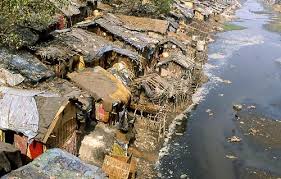Christine Mungai – Big Surprises: Why African Cities Should Look At Slums As The ‘New Normal’
mgafrica.com. August 2014. It’s the mantra of urban public policy in Africa: Slums are bad. Everyone should live in a decent house that doesn’t let in the cold and rain, has clean water to drink, and not have to jump rivers of sewage to get home.
But the story isn’t as straightforward as that—scratching past the surface can challenge some of the assumptions held about Africa’s “informal settlements”, as they are euphemistically called.
The proportion of city dwellers who live in slums can be staggeringly high in Africa—in most of western, eastern and central Africa, more than 50% of city residents live in slums, and it can be as high as 80% in Mozambique, Angola and Central African Republic (CAR).
The stereotypical image of a slum is that of a squalid, overcrowded settlement of dilapidated metal-and-cardboard shacks.
But some African cities “hide” their slums well. In Addis Ababa, for example, some 40% of the housing stock is formal, yet a quarter of those in supposedly good formal housing actually live in slum-like conditions—a quarter lack access to toilets, a third share toilets with more than six families, and 34% rely on public water taps that have unreliable supply.
Read more: http://mgafrica.com/article/surprises-from-the-slums
Tom Murtha – Don’t Worry Our Values Will Save Us
Profit for purpose, social business, business head social heart, value driven, social enterprise. I am sure you will recognise these terms. They are all used to describe housing associations in the new era. They are intended to show that even though housing associations are diversifying, entering new markets and becoming more commercial they are doing it to continue to deliver social values.
When I speak or write about the risks of diversification I am often told that there is nothing to worry about as the sector is still committed to strong social values and that its leaders will ensure that this continues to be the case. I have argued elsewhere that history shows that organisations who have gone down this route, even though they begin by making this claim, often end up by being driven by their financial imperatives and not their values. The reply to this is that I have no need to be concerned as the sector is in good hands. My question to those who say this is quite simple. How do you know that you are maintaining and protecting your values as well as you are protecting your financial and commercial activities?
Read more: http://tommurtha.wordpress.com/2014/08/26/dont-worry-our-values-will-save-us/
Al Jazeera – Rebel Architecture
Rebel Architecture is a six-part documentary series profiling architects who are using design as a form of activism and resistance to tackle the world’s urban, environmental and social crises.
The series follows architects from Vietnam, Nigeria, Spain, Pakistan, Israel/Occupied West Bank and Brazil who believe architecture can do more than iconic towers and luxury flats – turning away from elite “starchitecture” to design for the majority.
Read & see more: http://www.aljazeera.com/programmes/rebelarchitecture/
The Economist – South African Cities ~ Still Worlds Apart
August 2014. DRIVING through South Africa can be like taking a disheartening trip back in time. Twenty years after the introduction of full democracy, the racist geography of the apartheid era is stubbornly unchanged.
Most towns start with a collection of shacks, or perhaps rows of tiny matchbox houses, inevitably inhabited by blacks. A swathe of wasteland follows and then, further along, comes the town proper. Between the two, black people walk through fields or along roads—there are no proper pavements—or sometimes pile in and out of dilapidated minibus taxis en route from home to work. The effects of the Group Areas Act, which physically pushed non-whites to the margins of towns in 1950—at a distance, yet close enough to provide cheap labour—are still evident.
Read more: http://www.economist.com/stillworldsapart
Prachi Vidwans – Why The World Needs To Get Ready For The Next Generation Of Slums
transitions.foreignpolicy.com. August 2014. People who live in slums don’t have easy lives to begin with. Lately, though, politicians have been doing their best to make matters even more complicated. A few weeks ago the Venezuelan government started evicting Caracas’s infamous 45-story slum, the “Tower of David,” relocating residents to government housing outside the city. In early July, a few weeks earlier, a thousand slum dwellers in Islamabad found themselves confronting riot police as they tried to protest the Pakistani government’s plans to evict them from their homes (“katchi adabi” settlements). Around the same time, a local government in India approved plans to build the first of 10,000 new “transit accommodations” for displaced slum dwellers. That followed Bombay’s brutal anti-slum drive in May, when authorities bulldozed more than 100 family homes, forcing over 600 residents onto the streets.
If it seems like conflict over slums is mounting, that’s because it is: The urbanization of the world is accelerating. In 1950, just 29 percent of the world’s population lived in cities; back then, that was roughly 742 million people. Today, more than half of the world’s people — more than 3.5 billion — are citydwellers. That may sound like a dramatic shift, but you ain’t seen nothing yet. Roughly 70 million people move into cities every year, and the vast majority of them usually end up in illegal or informal urban settlements. According to U.N. estimates, by 2050, a third of the world’s population will live not just in cities, but in slums.
Read more: http://transitions.foreignpolicy.com/why_the_world
Crowded Earth: Where Is Everyone Going To Live?
60 million people every year are heading into the cities — and the UN estimates the trend is going to continue until 85% of the whole population end up living in the cities. We explored some of the strange things happening on earth in our cities.
Subscribe to our channel: http://bit.ly/TRUsub







